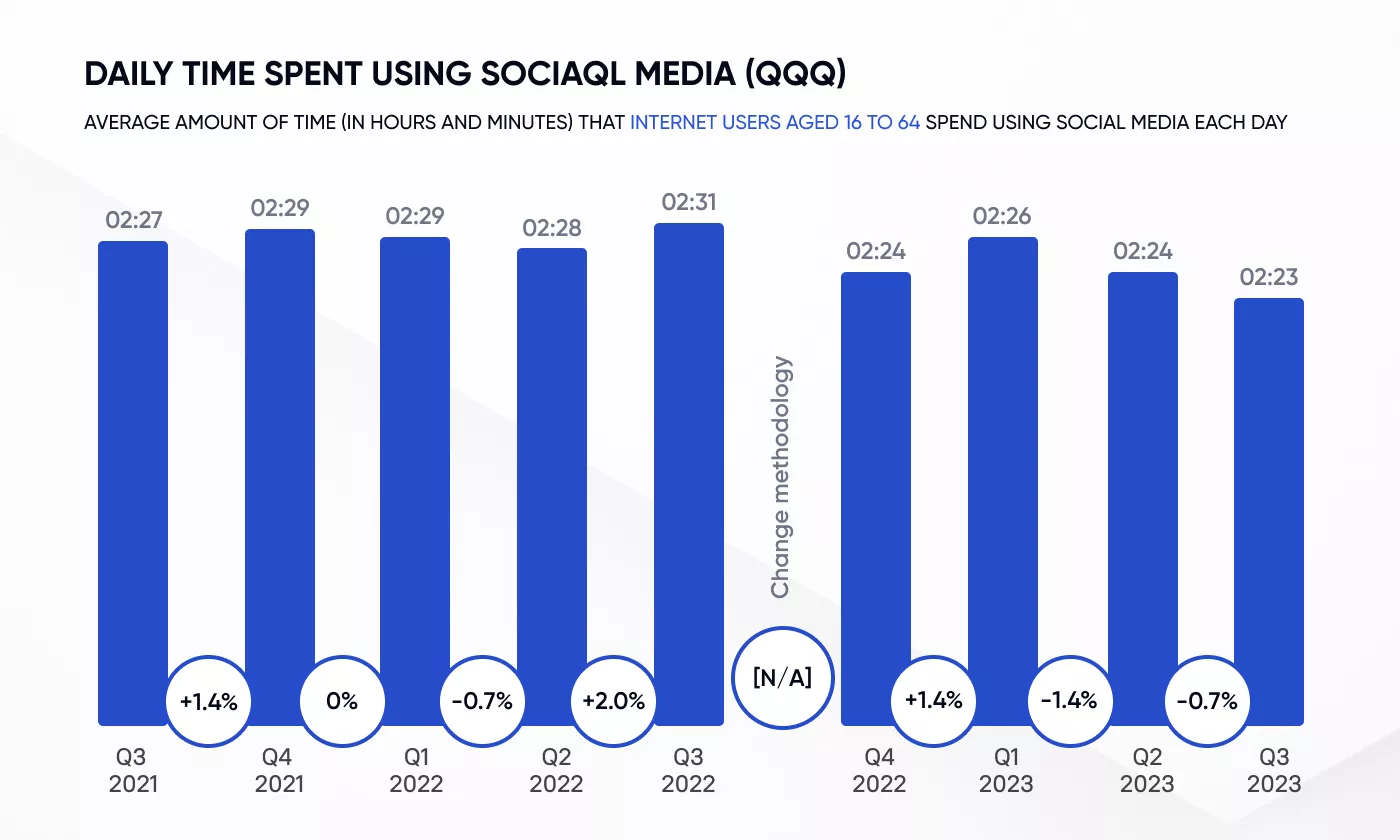
Imagine a world without social media apps. Boring, right? These apps have become an integral part of our lives. We spend hours scrolling through feeds, sharing updates, and connecting with friends and family.
In fact, the average person spends 143 minutes per day on social media.

Have you ever wondered what goes into building these addictive apps? It's not as simple as it seems. Creating a social media app is like putting together a giant digital puzzle – with millions of pieces!
In this blog post, we'll take you behind the scenes and reveal the secrets of how to make a social media app. From ideation to launch, we'll cover every step in easy-to-understand terms. By the end of this post, you'll have a solid understanding of what it takes to create the next big social media sensation. Who knows, you might even be inspired to build your own app and change the world – one post, one share, one like at a time!
Why Make a Social Media Application?
Before moving to how to build a social media app, let’s find out why you need this. Here are some compelling reasons why you might want to craft a social media application:
- Huge market potential. Social media is massive. At the beginning of April 2024, there were over 5 billion active social media users worldwide. That's over half the global population! With such a vast audience, a successful social application can reach incredible heights.
- Monetization avenues. Social media apps offer multiple revenue streams, such as advertising, premium features, e-commerce integrations, and subscription models. By building a successful social app, you can unlock new monetization opportunities.
- Data-driven insights. Social apps generate vast amounts of user data. It can be leveraged to gain valuable insights into consumer behavior, preferences, and trends. This data can inform product development, marketing strategies, and business decisions.
- Build communities. Social apps have the power to bring people together around shared interests, causes, or identities. Your application could foster vibrant digital communities and facilitate meaningful connections.
- Stay relevant. In today's digital age, having a strong social media presence is crucial for individuals and businesses alike. People are spending more time on social media than ever before. Building a social app allows you to tap into this growing consumer demand.
Want a web app that does more?
Let's build a solution that's smart, sleek, and powerful.
Alina
Client Manager

How to Create a Social Media App in 9 Key Steps
Developing a social media application is not an easy task. It requires careful planning, execution, and a deep understanding of user needs. Here are the key steps to build a successful social media service.
Create a strategy for your social media
The first step of how to create a social media application is developing a strategy. Define your app's purpose, goals, and unique selling points. Research the market and competitors. See what features they offer. Think about what you can do differently. Having a unique selling point is important. Outline your content strategy and plan for user engagement.
Decide if you want ads or in-app purchases. These monetization options impact design choices.
Decide on a social media app type
There are different types of social apps. Decide which one suits your goals best:
- Social networking apps like Facebook
- Media-sharing apps like Instagram
- Discussion forums like Reddit
- Dating applications like Tinder
- Messaging apps like WhatsApp
Each type has pros and cons. Consider the features you want. Social networking apps like Facebook, Twitter, and LinkedIn allow users to share updates, links, photos/videos and connect with friends/followers. The core value is fostering conversations and sharing content within your network.
Key features: Profile pages, newsfeeds, commenting, sharing capabilities
Media-sharing apps like Instagram, TikTok, and YouTube allow users to upload photos, videos, or live-stream content. The focus is on creatively expressing yourself and going viral.
Key features: Video uploads, image editing tools, filters, tagging, hashtags
Online communities like Reddit and Quora center around specific topics. Users can post questions, share opinions, and crowd-source information on particular subjects they're interested in.
Key features: Threaded discussions, upvoting, community moderation tools
Dating apps like Tinder, Bumble, and Hinge aim to facilitate romantic connections between people nearby. Users create profiles and can match and message with potential dates.
Key features: Location-based matching, swiping mechanics, in-app chat
Messaging apps like WhatsApp, Messenger, and Snapchat focused on enabling real-time text, voice, and video communication between contacts.
Key features: Contact lists, group chats, multimedia messaging
Consider which category aligns best with your app's main purpose and target user base. The type you choose shapes the fundamental architecture and experience of your application. It's one of the most critical decisions early on, so evaluate your options carefully.
Define target audience
Clearly define who your target users are, their age, interests, location, etc. Their psychographics, behaviors, motivations, and pain points are important. The features and design should appeal to this group specifically.
Research your target audience deeply. Look at their online behaviors and preferences. This data guides your design decisions. It ensures you build something they actually want to use.
Start with quantitative research - look at market data, surveys, social media analytics, and more to gather demographic insights. Go beyond just demographics. Use qualitative methods like focus groups and user interviews to develop deeper psychographic profiles. Understand their values, interests, lifestyles, and personalities. What are their goals and challenges? How do they think and make decisions?
Dive into their online behaviors too - which websites and applications do they frequent? How do they consume content and interact with their networks? What device and platform do they use?
Build detailed user personas that bring your target audience to life. Give them names, backstories, and goals. Reference these constantly throughout development to ensure you're solving the right problems for the right people.
Choose a profitable business model for your application
Decide how you will monetize your app from the start. Popular options include advertising, subscriptions, in-app purchases, or taking a cut of transactions. Your business model impacts product decisions, so be strategic. For example, subscriptions enable more advanced features while ads require driving high user volumes. Outline financial projections to ensure profitability. Let’s review the most common options:
- Advertising. Selling ad placements, sponsorships, or promotions within your application. Pros are it's free for users and can scale. Cons are it can disrupt user experience and requires high volumes.
- Subscriptions. Charging a recurring fee (monthly, yearly, etc.) for premium access or features. The benefit is that it gives recurring revenue. However, you need extremely valuable features.
- In-app purchases. Users can buy virtual items, boosts, unlocks, etc. Thus, you get monetization from engaged users. Cons are purchasers may lose interest over time.
- Transaction fees. Take a cut every time money is exchanged in your app for things like bookings, services, or digital goods. It has the potential for strong revenue but brings some complexity.
You can combine complementary models like ads plus in-app purchases. Yet, avoid getting greedy - prioritize the user experience.
Choose features for social network app development
When deciding on features, always tie them back to your core user needs and app purpose. Don't stuff in too many features. It's better to have a small set of exceptional, focused tools. That said, most social applications share certain foundational feature sets:
- Account setup & user profiles;
- Content creation & sharing;
- Newsfeeds / Activity streams;
- Connections / Networking;
- Direct messaging;
- Notifications;
- Search.
Beyond this typical core, pursue additional features. These can be live-streaming, ephemeral content, AR camera effects, audio/video conferencing, and more based on your goals. Don't just copy other popular apps though. Differentiate with innovative twists and prioritize your users' key needs above all.
Choose tech stack
Select the programming languages, frameworks, databases, and tool stack your developers will use. For social apps, common choices are JavaScript, React Native, Node.js, MongoDB, and AWS services. Your tech stack depends on factors like your developers' expertise, required performance, and scalability needs. Make sure to choose robust, proven technologies.
Develop
With planning done, it's time to build! Follow agile development practices, with iterations enabling fast feedback loops. Break development into sprints tackling priority features first. Conduct thorough testing, user research, and bug fixing. Iterate based on results.
Publish and market the application
Once your initial app version is ready, publish it on the relevant app stores (Apple App Store, Google Play Store, and/or web). Create compelling store listings with screenshots, descriptions, and preview videos that clearly convey your app's value and differentiation. Look at how other top social apps market themselves for inspiration.
The best marketing promotes your app's core value and unique differentiators. Highlight the key problems it solves for your target users. Use calls-to-action and incentives to drive downloads. Beyond just user acquisition, you'll need strategies for activation, retention, and monetization too. Leverage in-app messaging, push notifications, email drip sequences, and loyalty/referral programs.
Promoting a new social application is highly competitive. So be prepared to test many channels and double down on what's performing best.
Measure, gather feedback & analyze
Implement robust analytics to track key metrics like user growth, engagement, retention, revenue, and more. Continually gather feedback through surveys, reviews, and customer support, and monitor the social discussion. Analyze this data to guide product improvements, new features, and optimizations. Be prepared to evolve and pivot based on real-world usage.
Building a successful social media app requires immense planning and hard work - but seeing people engage with your creation makes it all worthwhile!
Mandatory Features of a Social Media App
Social media is the new normal. It's the modern version of the town square where people gather to chat, share news, and hang out. Just like the famous line from Field of Dreams - "If you build it, they will come." But for a social app to truly thrive, it needs the right essential features to attract users. Let’s review them.
User profiles
No social application is complete without letting people craft their digital identity. From display pics to bios to customizable details - give them ways to make their profile unique. People use profiles to express their identity online. The user profile is the core of the social experience.
Content sharing
This is what it's all about, yeah? Let people post photos, videos, opinions, and anything else they want to beam into the world. Make sharing content a smooth experience. "Content is king" - that old adage couldn't be more true for social media. People crave visuals to consume and get sucked into those infinite scrolling loops. Even LinkedIn realized it needed to embrace this by letting users upload basic video clips.
Reactions and comments
For any social app, reactions like likes and comments add interactivity. Users want ways to quickly acknowledge updates with reactions. Comments enable deeper discussions around posts. These interactions are the core social behaviors.
News feed
A news feed that displays updates from connections is essential. Users want to easily see new content shared by their friends, family, businesses, and interests they follow. The news feed keeps people engaged by constantly surfacing fresh, relevant updates.
Friending/Following
People join social apps to connect with others. They need the ability to send and accept friends or follow requests. This builds the user's network of connections. People can then share updates and interact with those connections.
Search
The ability to search for other users, topics, and content is mandatory. People search to find accounts to follow. They also search for specific types of updates using keywords or hashtags. The strong search keeps the application navigable.
Notifications
Notifications alert users about new activity. When someone reacts or comments on their post, notifications keep people in the loop. Notifications are the nudge that brings people back into the app.
Security and privacy controls
Last but definitely not least, we have the much-discussed privacy and security settings. Privacy settings allow users to customize who can see their profile, posts, and personal details. People want control over their digital footprint and comfort in knowing their data is protected. Make these settings robust yet user-friendly.
Social apps rise and fall based on their feature set. Designing for modern social behaviors keeps people engaged daily. The apps that master these mandatory social features will win users' time and loyalty.
How Much Does It Cost to Make a Social Media App?
Thinking about building your own social app? Wondering what the price tag looks like? Let's break it down. The total cost depends heavily on:
- What features are required,
- Design complexity,
- Tech stack chosen,
- Geographic hiring (dev rates),
- User acquisition strategy,
- Hosting/backend infrastructure.
An important question here is how long does it take to make a social media app. Even a basic social media app with core features like user profiles, newsfeeds, messaging, and sharing needs more than 1000 hours of coding work. More advanced apps with tons of extra functionality could need 2 thousand dev hours.
In the US, freelance rates for experienced app developers typically range from $100-$250 per hour. Eastern Europe has lower rates, around $50-$100 per hour. Places like India can be as low as $20 per hour.
Taking mid-range salaries of $100 per hour in the US, a basic 1200-hour social app could cost $120,000. And that's just the initial development cost! You'll also need funds for:
- UI/UX design ($5,000-$15,000)
- App store fees ($99-$299 per year)
- Servers/hosting ($60-$200+ per month)
- Ongoing maintenance/updates ($10,000+ per year)
- Legal/Admin ($2,500-$10,000+)
- Marketing/paid acquisition ($5,000-$100,000+)
The big takeaway? Building a social app isn't cheap. So if you're aiming to build the next big social hit, be prepared to invest some serious cash upfront and ongoing. But, with the right product-market fit, audience, and monetization model, that upfront investment can pay off.
How Can Stfalcon Help You To Develop A Social Media Application?
If you need assistance bringing your social app idea to life, the team at Stfalcon has extensive experience building social media and networking apps for clients. Our skilled developers can help you with each stage of the process.
We start by working closely with you to understand your goals, concept, target audience, and requirements. Our UX design experts then create intuitive wireframes and user flows optimized for your use case. Our company constructs scalable, high-performance apps adhering to security best practices.
Here are a couple of examples of social apps we've built:
Triplook is a unique travel and dating app with social networking elements. It allows users to easily find fellow travelers to join them on trips or vacations. We developed the design as well as iOS and Android mobile apps for Triplook. Our team built the server-side as a convenient REST API.
UME is a dating app for Android and iOS that connects people looking for relationships. For the UME startup, we built a prototype, full iOS and Android apps, and the supporting API.
Conclusion
Building and launching a successful social networking application requires tremendous work. Yet, the potential payoff makes it worthwhile. Social media is ingrained into modern life, creating opportunities for innovative apps to cultivate large, highly-engaged user bases.
By following the steps outlined above, you can bring your social app concept into reality. Define a clear purpose, study competitors, prioritize an MVP feature set, and assemble the right tech stack and team.
Of course, social app development is a major undertaking. Having an experienced technical partner like Stfalcon can make the process much smoother. Our team provides end-to-end social app development service to handle each stage based on best practices.
Contact Stfalcon today to discuss how we can collaborate to design, build, and launch your new social app idea! Let's get started bringing your project to life.
Here are the answers to the most common questions about how to make a social networking app.
FAQs about creating a social media app
What are the initial steps to create a social media app?
The initial steps involve defining the app's purpose and target audience. Research the market to identify gaps and opportunities. Develop wireframes and prototypes to visualize the user experience. Choose the technology stack and programming languages. Build the core features like user profiles, newsfeeds, and messaging. Finally, you will need to test the app thoroughly before launching.
How do I ensure user data security and privacy?
To ensure data security and privacy, you should implement strong encryption for data storage and transmission. Regularly update your security measures and conduct penetration testing. Provide clear privacy policies and obtain user consent for data collection and usage. Additionally, comply with data protection regulations like GDPR.
What are the essential features of a social media application?
Essential features include user registration and profile creation, newsfeed for content sharing, messaging or chat functionality, notifications, search and discovery capabilities, content creation and sharing tools, and integration with other platforms. Additionally, consider features like groups, events, analytics, and advertising options.

 Read the full case study
Read the full case study
 Read the full case study
Read the full case study


